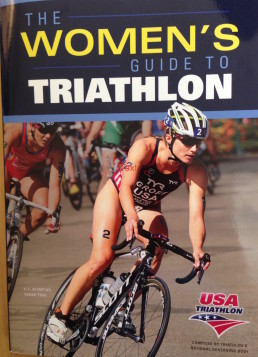The Women’s Guide to Triathlon
This book presents female specific training, techniques and equipment for triathlon. Guided by the USAT Women’s Committee, whose goal is to encourage women’s participation in the sport, 20 of the sport’s top female coaches and athletes offer their winning advice.
I am proud and honored to be one of the authors of this fantastic book. Chapter 9: Progressing From Sprint to Half Ironman. In this chapter, I have created training plans to follow for both the novice and intermediate triathlete; a road map to follow to your dreams and goals.
Check out an exclusive excerpt of my chapter…..
Measuring Intensity
The ability to measure your training intensity, easy or hard, is key to achieving your performance and participation goals. Many devices can measure intensity: heart rate monitors, GPS (Global Positioning System) devices, and power meters. These are all great training tools, and at some point in your training career you may want to use one. But one of the simplest methods of measuring intensity is to use the rating of perceived exertion (RPE). I prefer the modified Borg scale from 1 to 10. A rating of 1 would be sitting down; 10 of 10 is a 100 percent, all-out effort (see table 9.1). I use this scale throughout the training plans.
The next option would be to use a heart rate monitor and calculate training zones. I have also included training zones throughout the sample training plans. Here is how to calculate your heart rate training zones:
- Take your resting heart rate first thing in the morning. Lie down comfortably, put on your heart rate monitor strap, relax, and read the lowest number on the watch.
- Calculate your max heart rate with this formula: 217 − (age × .85).
- Calculate your heart rate reserve (HRR) with this formula: max HR − resting HR.
- Calculate the percent of effort required for the target zone (see table 9.2) with this formula: HRR × percent effort = Z.
- Add Z to your resting heart rate to get your final value.
For example, let’s consider a 35-year-old triathlete whose resting heart rate is 60:
217 − (35 [age] × .85) = 187.25 (max HR)
187.25 (max HR) − 60 (resting HR) = 127.25 (HRR)
127.25 × 70 percent (zone 4) = 89.075 (Z)
60 (resting HR) + 89.075 (Z) = 149.075 (HR training zone for zone 4)
Calculate your values for all the training zones.
Customizing the Plans
These plans are meant to be guides to help you on your journey to triathlon race success, but they are generalized. We all come to this sport with different strengths and weaknesses in each discipline. In order to better individualize these plans, the simple rule of thumb is to increase or decrease overall volume (time per session) by 10 to 30 percent, more if you can handle more, less if you need a slower progression. We all have our own individual rates of adaptation. Be willing to challenge yourself, but pay attention to overstress and overtraining, which may lead to illness or injury. You can also use the same 10 to 30 percent rule to add to or subtract from the volume of intensity, again more or less to fit your level of fitness and ability in a particular sport.
Choosing a Race and Race Strategy
When choosing a race, consider the time of year you want to race, whether a local or destination race is right for you, and both the terrain and weather conditions. If you live in a cold climate, it’s best to pick a race that is later in the season, say July or August. This gives you ample outdoor warm-weather training time to prepare
For first-time racers, I recommend a local race to get started. The environment and terrain are familiar, and you have the support of friends and family on race weekend. There are some amazing choices of destination races around the country and around the world. Visit www.usatriathlon.org/events to find a race near you. Traveling does involve more challenges and unknowns. For example, traveling with your bike is costly.
You’ll need to consider terrain and climate when making a choice about where to race. Do you live in a flat state but want to race in a hilly state? Make sure you do a thorough investigation about the race course before making a decision. To the best of your ability, tailor your training to that specific terrain and those conditions.
When putting together a race strategy, terrain and weather conditions are a primary consideration. Is it going to be hot? Cold? Rainy? Will you be prepared to face any conditions on race day? Preparation is key. For example, don’t avoid riding on windy days in training, as you could easily encounter strong winds on race day.
Once you choose a race, spend some time training on the course. The day before or day of the race, familiarize yourself with the flow of the transition area. Where will you rack your bike and set up your gear? Strategy must also be based on your abilities, fitness level, and confidence. For example, if you are new to swimming and open-water swim races, be sure to first train in the open water and then line up near the back or to the side on your wave start.
There is a bit of a learning curve with regard to pacing. Include race pace or race effort training (as in the template examples) once you are four to six weeks out from your race. For races that are going to take more than an hour, race day nutrition is a key component to success. Train your digestive system to handle sport nutrition during your training sessions so you can avoid stomach upset on race day.
The Women’s Guide to Triathlon is now available at HumanKinetics.com, at your local bookstore, or at major online bookstores.
